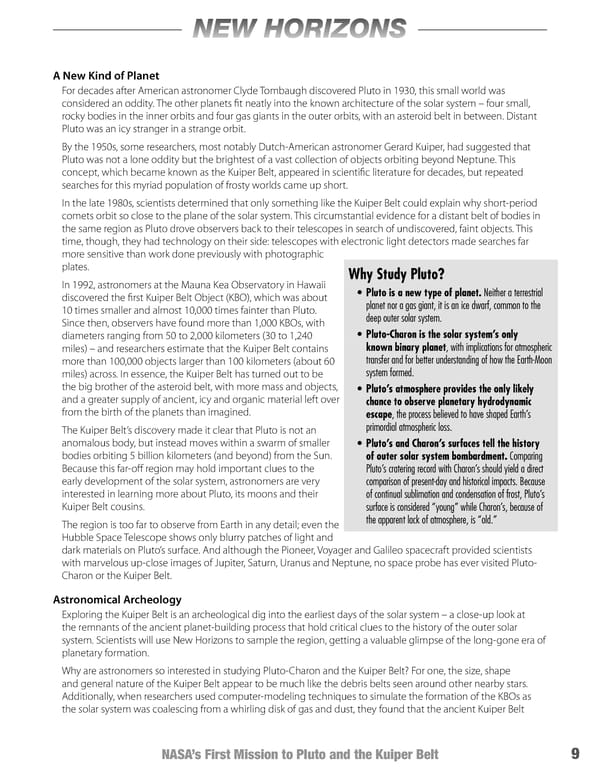NEW HORIZONS A New Kind of Planet For decades after American astronomer Clyde Tombaugh discovered Pluto in 1930, this small world was considered an oddity. The other planets fit neatly into the known architecture of the solar system – four small, rocky bodies in the inner orbits and four gas giants in the outer orbits, with an asteroid belt in between. Distant Pluto was an icy stranger in a strange orbit. By the 1950s, some researchers, most notably Dutch-American astronomer Gerard Kuiper, had suggested that Pluto was not a lone oddity but the brightest of a vast collection of objects orbiting beyond Neptune. This concept, which became known as the Kuiper Belt, appeared in scientific literature for decades, but repeated searches for this myriad population of frosty worlds came up short. In the late 1980s, scientists determined that only something like the Kuiper Belt could explain why short-period comets orbit so close to the plane of the solar system. This circumstantial evidence for a distant belt of bodies in the same region as Pluto drove observers back to their telescopes in search of undiscovered, faint objects. This time, though, they had technology on their side: telescopes with electronic light detectors made searches far more sensitive than work done previously with photographic plates. Why Study Pluto? In 1992, astronomers at the Mauna Kea Observatory in Hawaii • Pluto is a new type of planet. Neither a terrestrial discovered the first Kuiper Belt Object (KBO), which was about planet nor a gas giant, it is an ice dwarf, common to the 10 times smaller and almost 10,000 times fainter than Pluto. deep outer solar system. Since then, observers have found more than 1,000 KBOs, with diameters ranging from 50 to 2,000 kilometers (30 to 1,240 • Pluto-Charon is the solar system’s only miles) – and researchers estimate that the Kuiper Belt contains known binary planet, with implications for atmospheric more than 100,000 objects larger than 100 kilometers (about 60 transfer and for better understanding of how the Earth-Moon miles) across. In essence, the Kuiper Belt has turned out to be system formed. the big brother of the asteroid belt, with more mass and objects, • Pluto’s atmosphere provides the only likely and a greater supply of ancient, icy and organic material left over chance to observe planetary hydrodynamic from the birth of the planets than imagined. escape, the process believed to have shaped Earth’s The Kuiper Belt’s discovery made it clear that Pluto is not an primordial atmospheric loss. anomalous body, but instead moves within a swarm of smaller • Pluto’s and Charon’s surfaces tell the history bodies orbiting 5 billion kilometers (and beyond) from the Sun. of outer solar system bombardment. Comparing Because this far-off region may hold important clues to the Pluto’s cratering record with Charon’s should yield a direct early development of the solar system, astronomers are very comparison of present-day and historical impacts. Because interested in learning more about Pluto, its moons and their of continual sublimation and condensation of frost, Pluto’s Kuiper Belt cousins. surface is considered “young” while Charon’s, because of The region is too far to observe from Earth in any detail; even the the apparent lack of atmosphere, is “old.” Hubble Space Telescope shows only blurry patches of light and dark materials on Pluto’s surface. And although the Pioneer, Voyager and Galileo spacecraft provided scientists with marvelous up-close images of Jupiter, Saturn, Uranus and Neptune, no space probe has ever visited Pluto- Charon or the Kuiper Belt. Astronomical Archeology Exploring the Kuiper Belt is an archeological dig into the earliest days of the solar system – a close-up look at the remnants of the ancient planet-building process that hold critical clues to the history of the outer solar system. Scientists will use New Horizons to sample the region, getting a valuable glimpse of the long-gone era of planetary formation. Why are astronomers so interested in studying Pluto-Charon and the Kuiper Belt? For one, the size, shape and general nature of the Kuiper Belt appear to be much like the debris belts seen around other nearby stars. Additionally, when researchers used computer-modeling techniques to simulate the formation of the KBOs as the solar system was coalescing from a whirling disk of gas and dust, they found that the ancient Kuiper Belt NASA’s First Mission to Pluto and the Kuiper Belt 9
 New Horizons Page 15 Page 17
New Horizons Page 15 Page 17